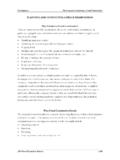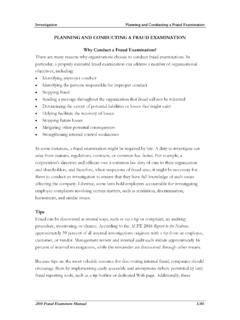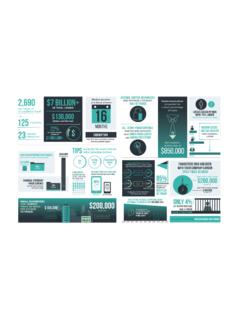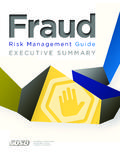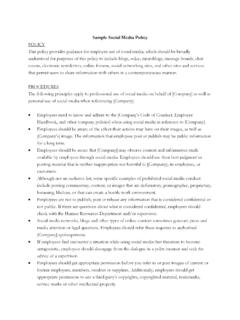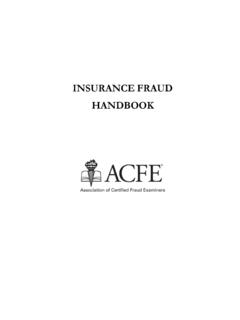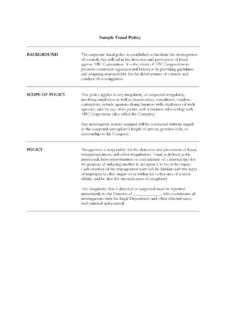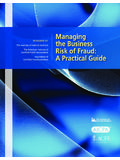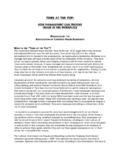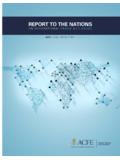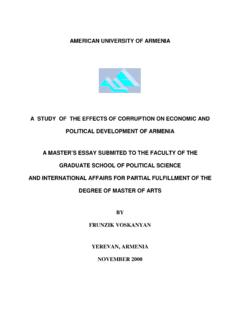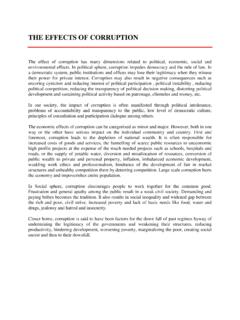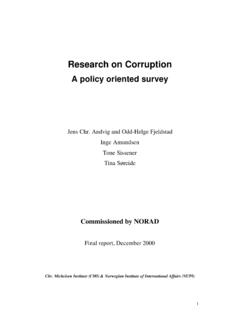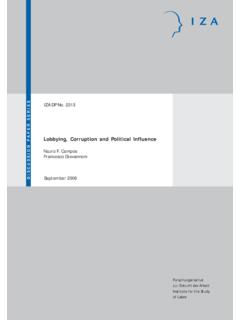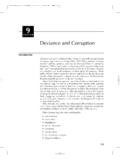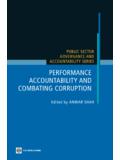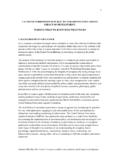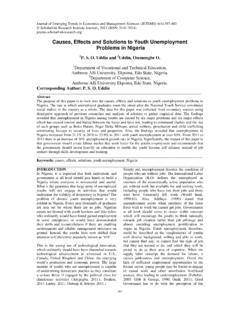Transcription of CONFLICT OF INTEREST: GATEWAY TO CORRUPTION
1 2014 CONFLICT OF INTEREST: GATEWAY TO CORRUPTION All acts of CORRUPTION contain an inherent CONFLICT of interest and can remain undetected in an organisation for years, if indeed they are detected at all. Anatomising the corrupt act can illustrate how employee CORRUPTION can begin and evolve even from benign situations, and how good management can mitigate the risk of CORRUPTION occurring internally. In this session you will learn new strategies to prevent, manage, and detect CORRUPTION risk within an organisation. PAUL CATCHICK, , CFE Senior Investigator Organization for Security and Co-operation in Europe (OSCE) Austria Paul Catchick has more than 20 years of experience with law enforcement and government agencies in Europe, Africa, and the Asia-Pacific region. This has included criminal investigation work with the UK Serious Fraud Office and a period as Head of Investigations for a national anti- CORRUPTION agency.
2 Subsequently, he moved to the United Nations where he investigated internal misconduct, specialising in large-scale fraud cases. He then left to establish the internal investigation section at the Organization for Security and Co-operation in Europe. More recently, he was awarded a doctorate in policing. Association of Certified Fraud Examiners, Certified Fraud Examiner, CFE, ACFE, and the ACFE Logo are trademarks owned by the Association of Certified Fraud Examiners, Inc. The contents of this paper may not be transmitted, re-published, modified, reproduced, distributed, copied, or sold without the prior consent of the OF INTEREST: GATEWAY TO CORRUPTION 2014 ACFE European Fraud Conference 2014 1 NOTES Introduction CORRUPTION cannot exist without a CONFLICT of interest. Each and every corrupt act is driven by an underlying CONFLICT . This session aims to alert organisations management to the importance of this connection, and to highlight that if conflicts of interest can be controlled, CORRUPTION will be minimised.
3 Aside from the natural desire to avoid being a victim of CORRUPTION , management s need to demonstrate financial integrity in an era of compliance and regulation is more urgent than ever before. It can be important to take active measures to guard against CORRUPTION perpetrated or assisted from within. Understanding the relationship between conflicts of interest and CORRUPTION can lead to new ways to deter and detect misconduct. Controlling CORRUPTION is a task for which staff members across an organisation have responsibilities. Management, internal audit, and investigators can each share responsibility for preventing and identifying CORRUPTION . Individuals must also take responsibility for their own actions, but an organisation can more easily hold individuals accountable if it has first set out its rules and expectations. CONFLICT of Interest as an Integral Component of CORRUPTION There is a curious lack of attention given to the role of conflicts of interest in CORRUPTION .
4 While whole industries revolve around ethics and CONFLICT of interest issues, its key role as an integral component of CORRUPTION is largely overlooked. Even the United Nations Convention Against CORRUPTION (UNCAC) makes only cursory reference to conflicts of interests, despite being the backbone of CORRUPTION legislation worldwide. CONFLICT OF INTEREST: GATEWAY TO CORRUPTION 2014 ACFE European Fraud Conference 2014 2 NOTES Part of the reason might relate to the difficulties in understanding the exact nature of conflicts of interest. Different understandings can apply in differing governance contexts, which may help explain why some western media and officials perceive that other cultures often give scant regard to the concept (see for example ). Indeed, it can be difficult enough to explain the concept of CORRUPTION let alone conflicts of interest to societies whose values are traditionally based on familial or tribal relationships, or those in post- CONFLICT , failing, or failed states.
5 Nevertheless, CORRUPTION exists to some degree in almost any culture. Even societies or sectors that traditionally have minimal CORRUPTION are increasingly exposed to different ideas and values through the effects of globalisation. To understand why CORRUPTION must always involve a CONFLICT of interest, let s look at the definitions of the respective terms. The Organisation for Economic Co-operation and Development states: CONFLICT of interest occurs when an individual or a corporation (either private or governmental) is in a position to exploit his or their own professional or official capacity in some way for personal or corporate benefit ( ). In other words, a CONFLICT of interest exists when someone could abuse his or her official position for private gain. Turning to the definition of CORRUPTION , the World Bank has provided a very succinct definition: the abuse of public office for private gain ( ).
6 While the World Bank definition focuses on public-sector CORRUPTION , the definition is largely interchangeable with CONFLICT OF INTEREST: GATEWAY TO CORRUPTION 2014 ACFE European Fraud Conference 2014 3 NOTES private-sector CORRUPTION since the term public office can equally apply to any official or any office whether public or commercial held by an employee. Comparing these definitions shows why the two concepts are so closely intertwined. A CONFLICT of interest exists where an official could abuse their position for private gain, whereas CORRUPTION exists where an official does abuse their position for private gain. Thus while a CONFLICT of interest doesn t always lead to CORRUPTION , CORRUPTION always requires a CONFLICT of interest. For example, accepting bribes is an example of CORRUPTION . The bribe taker has put his or her private gain the receipt of the bribe above the need to act in the best interests of his or her employer.
7 Thus, there s both a CONFLICT of interest and resulting CORRUPTION . Acts of CORRUPTION in response to blackmail and extortion are similar. A person being blackmailed into committing a corrupt act is putting private interests (for example, maintaining their reputation) ahead of his or her fiduciary responsibilities. While the motivations may differ, the corrupt act is committed after the employee decides to put private interests ahead of official responsibilities. CORRUPTION does not have to involve two or more parties in wrongdoing. A single person in a position of trust can break corporate rules for their own benefit. For example, an immigration official who issues an unauthorised passport in his own name or an employee who furtively gives business to another company under his control. These are still acts of CORRUPTION . Every CONFLICT of interests requires one party to be in a position of trust, and every instance of CORRUPTION requires a both a CONFLICT of interests and a breach of that trust.
8 CONFLICT OF INTEREST: GATEWAY TO CORRUPTION 2014 ACFE European Fraud Conference 2014 4 NOTES Thus, the elements of CORRUPTION include: A position of trust A CONFLICT of interest between that position of trust and a private concern A resultant action that breaches that trust the corrupt act Note that the CONFLICT of interest only appears on one side of the equation. In bribery, for example, the bribe-payer is getting the bribe-taker to abuse his position of trust. It is the person who has been corrupted who abuses his trust through a CONFLICT of interest. This knowledge facilitates the employer s task of preventing and detecting conflicts of interest and CORRUPTION . CORRUPTION might not involve only money or physical items. There could be other motivations, such as honours, educational qualifications, friendship, or societal or family pressure. Conflicts of interest that exist in a job recruitment process might lead to nepotism or cronyism, which are both forms of CORRUPTION .
9 In addition to actual conflicts of interest, there exist perceived conflicts of interest and potential conflicts of interest: Perceived conflicts exist where there might be no actual CONFLICT , but third parties might reasonably believe that a CONFLICT exists. Even though no actual CONFLICT exists, the perception can be damaging to the reputation of the parties who are believed to have one. In addition to reputational damage, there could be an indirect financial impact as better value suppliers might be reluctant to go to the trouble of preparing quotes if they perceive that their efforts will be in vain. CONFLICT OF INTEREST: GATEWAY TO CORRUPTION 2014 ACFE European Fraud Conference 2014 5 NOTES Potential conflicts exist where there might be no actual CONFLICT , but the possibility of one existing in the future is reasonably foreseeable. Prevention The potential exists for confusion over the definitions, meanings, and applications of conflicts of interest, particularly in a globalised or multicultural environment.
10 The solution is to ensure that those in a position of trust ( , the staff in an organisation) are able to understand and recognise of all types of conflicts of interest and are made aware of the procedures for handling such a CONFLICT . Very often, CONFLICT of interest and CORRUPTION awareness is aimed at procurement officials. While an important area to control, all staff and in particular those who deal with external parties are at risk of having a CONFLICT of interest. Even in a purchase transaction, staff other than procurement officials could gain from a relationship with a supplier. For instance, those involved in the requisition of goods might influence the award of business to some extent, while those in accounts might have some control over payments. Stock control and warehouse staff might also be able to abuse the supplier relationship. Organisations will additionally benefit from ensuring that those staff members not directly involved in engaging with external parties are aware of CONFLICT of interest issues, both from the point of view of (i) avoiding perceived conflicts, and (ii) encouraging staff to identify and report misconduct among co-workers.
